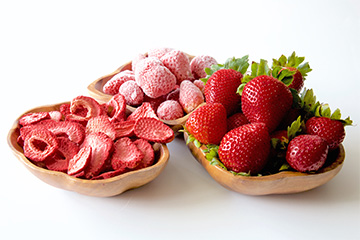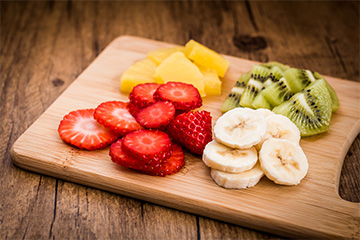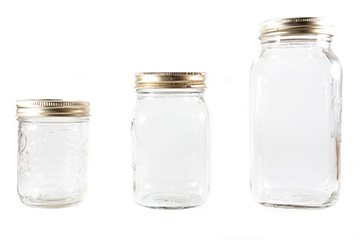
Strawberries

Though it may still feel like winter at times, local strawberries will be in season soon! Strawberries are not only a sure sign of spring, but also a very nutritious food. One cup of strawberries has only 53 calories, while providing 3 grams of fiber and 97 mg of vitamin C — more than 1.5 times the daily recommended amount.
Harvest strawberries when they are bright red with a short piece of stalk attached. Avoid mushy, shriveled or wet berries. Cool the strawberries as quickly as possible after you harvest or purchase them, and store them in the refrigerator (at as close to 32 degrees F as you can get without freezing them) for no more than one to three days before use. Rinse your strawberries under cool running water immediately before using them.
Strawberries can be served or preserved in a number of ways:
- Raw
- Within various recipes
- Made into preserves, syrup or fruit leather
- Dried
- Frozen
You can freeze strawberries without sugar as whole, sliced or crushed berries using a dry pack. Simply pack the strawberries into a container, seal and freeze. Or you can use the tray pack method, spreading a single layer of prepared strawberries on shallow trays and freezing them. Once they’re frozen, promptly package the berries and return them to the freezer. The fruit pieces remain loose, and you can pour a portion from the container and reclose the package. Prevent freezer burn by packaging the fruit as soon as it is frozen. You also can freeze strawberries using a sugar or syrup pack, sliced or crushed with sugar. Strawberries do not require blanching before they’re frozen.
To dehydrate strawberries, sort and wash them carefully before halving and slicing them, if desired. No other pretreatment is necessary. Preheat your dehydrator following manufacturer instructions. Arrange the prepared strawberries on your drying trays, leaving small spaces between pieces for good air circulation. Turn large pieces halfway through drying. Move pieces near the tray sides to the center or stir the small pieces to ensure even drying. Rotate trays if recommended by the dehydrator manufacturer. Check for dryness at the end of the minimum drying time, and then more frequently as the drying progresses. Drying time is normally 24–36 hours. Let a sample piece cool to room temperature before testing. Dried strawberries should be leathery and pliable with no moisture when the drying is complete. Package dried foods in glass jars, food storage containers or plastic food storage bags in small amounts. Store containers in a cool, dark, dry area to maintain quality.
Sources:
Mills-Gray, Susan. 2018. "How to Dehydrate Foods." University of Missouri Extension. Last reviewed May. https://extension.missouri.edu/gh1563.
Andress, E.L., and J. A. Harrison. 2014. So Easy to Preserve, 6th ed. Bulletin 989. Athens, GA: University of Georgia Cooperative Extension Service.
Nutritionix. 2016. "Strawberries, Raw — 1 Cup, Sliced." Last updated February 22. https://www.nutritionix.com/i/usda/strawberries-raw-1-cup-sliced/513fceb575b8dbbc2100118a
Frozen Fruit Cups

Ingredients:
- 2 cups fresh strawberries, sliced
- 2 teaspoons sugar
- 1 medium to large banana, sliced
- 2 kiwi, sliced
Instructions:
- Mix strawberries with sugar in a bowl. Let mixture sit 20–30 minutes while strawberries make juice.
- Add banana and kiwi to strawberries.
- Scoop ½ cup of the mixture into each of six muffin cups lined with paper liners.
- Freeze. Remove from freezer about 20–30 minutes before serving.
Source: Iowa State University Extension and Outreach. n.d. "Frozen Fruit Cups." https://spendsmart.extension.iastate.edu/recipe/frozen-fruit-cups/.
Other resources:
Mills-Gray, Susan. 2017. "Quality for Keeps: Freezing Basics." University of Missouri Extension. Last reviewed April. https://extension.missouri.edu/gh1501.
Penner, Karen P., and Jeanne Dray. 1995. "Preserve It Fresh, Preserve It Safe: Strawberries," rev. ed., ed. Karen Blakeslee. K-State Research and Extension. www.bookstore.ksre.ksu.edu/pubs/MF1178.PDF.
K-State Research and Extension. n.d. "Drying." https://www.rrc.k-state.edu/preservation/drying.html.
Canning Q&A

I’d like to can foods in half-pint jars, but most recipes use pint or quart jars. Is it possible to use smaller jars?
Canning containers come in sizes ranging from 4-ounce to half-gallon jars. But pint and quart jars are used most commonly, and processing times have not been developed for many foods in 4-ounce or 12-ounce jars. If the recipe does not specify processing in these jars, process 4-ounce, 8-ounce and 12-ounce jars for the same amount of time as you process pints. Jar sizes in between pints and quarts, such as 24-ounce or 28-ounce jars, should be processed like quart jars. Half-gallon canning jars are recommended only for apple and grape juice.?
??????Remember, you cannot increase the canning jar size unless the recipe explicitly says so, but you can decrease it.
Source: National Center for Home Food Preservation. n.d. "General Canning Information." https://nchfp.uga.edu/how/general/recomm_jars_lids.html.
What kind of container can be safely used to soak or brine pickled products?
For short-term brining or soaking, use crocks, saucepans or bowls made from stoneware, glass, stainless steel, aluminum or unchipped enamelware. Food-grade plastic also is acceptable. Except for aluminum, the same containers can be used for soaking vegetables in lime. Lime pits aluminum containers and increases the level of aluminum in pickles. Other large containers can be lined with a large food-grade plastic bag. Do not use garbage bags or trash can liners; these are not for food-contact use.
Source: Andress, E.L., and J. A. Harrison. 2014. So Easy to Preserve, 6th ed. Bulletin 989. Athens, GA: University of Georgia Cooperative Extension Service.
My aluminum canner has darkened on the inside. How can I clean it?
You can clean the darkened surface by covering the darkened area with a mixture composed of 1 tablespoon of cream of tartar per quart of water. Place the canner on the stove, heat water to a boil and boil with the cover on until the dark deposits disappear. Sometimes stubborn deposits may require additional cream of tartar. Empty the canner and wash it with hot soapy water, then rinse and dry.
Source: Andress, E.L., and J. A. Harrison. 2014. So Easy to Preserve, 6th ed. Bulletin 989. Athens, GA: University of Georgia Cooperative Extension Service.
I’ve lost the instruction manual for my canner. Where can I find a replacement manual?
Links to several websites with canner replacement parts and manuals are available at http://www.rrc.k-state.edu/preservation/index.html.